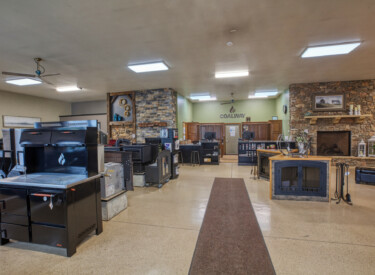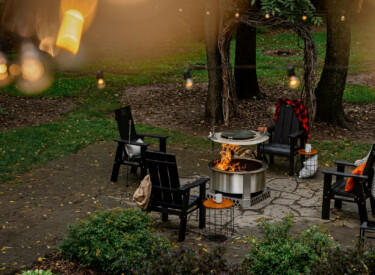Here in Ohio, with how cold some of the winter months can get, having high quality wood to burn can become a priority. Not only is wood important to burn in fireplaces during when it’s cold, but it is also beneficial to use during late night bonfires in the summer.
Deciding on where to store your firewood can be a make or break. Choosing a poor spot to keep your wood inventory can result in wood that:
- Is very damp
- Difficult to ignite and keep burning
- Will produce lots of smoke and creosote
- Can be full of mold and pests
But did you know, that proper wood storage is not that hard of a thing to manage. It will just require some planning to avoid future problems. One thing to always remember is that, you want your firewood to be as dry as possible and bug-free. Some people leave their wood to dry naturally over time, while others speed up the process and ensure the wood will be pest-free, by drying it in a kiln.
Once you have acquired all the firewood you need to store, use these essential tips to successfully keep your wood in the best shape possible.
1. Always Give Firewood That’s Outside, Space to Breathe
Most people tend to just store their firewood outside, which is fine. Make sure if you choose to do this, that you give your firewood plenty of space to breathe. Having space, can help to protect from moisture and insects preying upon the wood.
There are usually three types of firewood that need space in order to ensure quality burns in the future. Those are: green, seasoned, and kiln-dried firewood. Some tips we suggest for giving your wood space are:
- Keep the wood away from the ground at all costs. Make sure it is elevated, allowing for better airflow.
- Try not to put wood too close to house or other nearby structures.
The whole idea behind elevating wood off the ground, is to protect it from insects and moisture getting to it. Leaving wood in an un-organized pile on the direct ground can result in these things if you’re not careful. Try to lift the wood off the ground and store on wood pallets, concrete, boards, or just about anything that will keep it away from moisture.
It is always a good idea to keep firewood a good 15-20 ft. away from the house. This is because, when it is right up against your house, bugs and other termites can easily land and hang out there. They can also get into your home siding and other living spaces from this. Having your wood to close to the house, could also be a possible fire hazard. *It is to also be noted… never put your wood stack in a garage, basement, or attic as this can also lead to a bug infestation.
2. Don’t Store Firewood Indoors Unless It Is Kiln-Dried
In the bigger picture, you will only have two options for storing firewood; indoors or outdoors. This decision will need to depend on the type of wood you have available. Green, kiln-dried, and seasoned wood are the basic types most people have.
- Green Firewood: Chopped from a tree recently and hasn’t had the change to dry just yet.
- Kiln-Dried Firewood: Wood that has been dried in a kiln at a high temperature for about 36 hours. Moisture content needs to be below 20% to kill of all possible pesticides.
- Seasoned Firewood: Air-dried firewood that has been drying for at least 6 months to reduce its moisture levels.
Always remember.. green and seasoned firewood are the two types that should never be stored inside. They often contain moisture, bugs, mold, etc.
Kiln-dried wood is the only type to be kept indoors. Due to its process of drying, you can trust that this wood will not contain much moisture or pesticides at all. Keep green and seasoned wood outside to naturally air dry, and if your wood is kiln-dried bring it on in for storage.
3. Protect Wood From Outdoor Elements
This should be an obvious point, but make sure to take priority in keeping your firewood safe. You can do this by being mindful of where you put your wood stack. Avoid areas of your yard that typically take a lot of water or moisture. But also, place the stack somewhere that will get sunlight each day. This will help keep it dry and healthy.
Then you’ll want to choose a solid structure to keep your firewood on. This can be a concrete slab, a rack with a tarp on it, etc. Having a tarp on top of your wood will ensure protection from rain, snow, or sleet.
4. Stack Firewood Correctly
Choosing how to stack your wood, is just as important as choosing where to store it. Restricting airflow to the wood can cause dampness and mold.
Prevent this by stacking wood in one row with the pieces facing the same way and at least two feet space on both sides. Never stack them too tightly, leave small gaps in between the firewood pieces so the air can get to them.
*If using green or seasoned wood outside, it has been recommended to stack the wood bark-side down. The water will evaporate faster this way. Other woods like kiln-dry, can be stacked bark-side up because it just doesn’t need to dry any longer.

Stack firewood loosely like this
5. If Storing Indoors, Choose Location Strategically
Those who have kiln-dried wood or plan to try it in the future, this is for you. Being able to store this type of wood indoors is a great option, because you don’t have to worry about bugs or wetness. Still though, you need to choose the right room to store it in so it can stay fresh.
Always choose a room that has a low humidity and also allows for plenty of airflow! Most the time a basement will fit all of these requirements in most homes (sometimes even a garage). So if you choose perhaps a basement or garage to store your kiln-dried wood in, just remember the same advice for storage. Have plenty of space in between each piece for proper airflow. Don’t stack the wood higher than four feet to avoid safety hazards.



